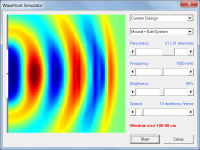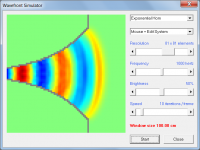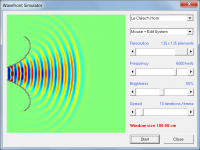In terms of wavelength, the boundaries of a horn may either define pattern control, or define the frequency where the horn is too small to control the pattern of a long wave.
I'm pretty sure we're on the same page. The rule-of-thumb is that a horn has good off-axis response, up to the frequency equal to the wavelength-diameter of the horn. Above this frequency, the horn becomes more directional (less off-axis response).
The point I'm trying to make is that if my stereo bass horns are 15 feet in diameter each, frequencies from 75 Hz and down are going to exit the horns almost side-by-side (with about 10 inches of concrete separating the waves) and specifically not from a 15 feet point-source distance. I'm thinking that 75 Hz at a spacing of 10 inches, is going to combine just fine without lobing. Or said another way - I am not convinced that my stereo bass horns are going to suffer significant lobing issues below 75 Hz. . . . as they are specifically NOT point sources - the sound is originating from a planar surface.
Last edited:
@Eric, I wonder whether the point (if there is one) might be whether standing waves are produced?
One of the prime reasons I'm building my system outside, is to free myself of room nodes.
In my line of work, we must carefully control resonant frequency, and critical frequency. If a pump goes out-of-balance and excites the natural frequency of the pump/foundation structure - you might just snap a 5-ton 400 horsepower pump right off its foundation. . . . This is the mechanical equivalency of a sanding wave. . . . Everything has a natural frequency. . ..
Or said another way - I am not convinced that my stereo bass horns are going to suffer significant lobing issues below 75 Hz. . . . as they are specifically NOT point sources - the sound is originating from a planar surface.
No, the sound is originating from the point source(s) at the throat of the horn, the drivers. At the horn mouth the wave isn't planar either, it's a bubble shape as you would expect from a sound wave since sound is round.
Hornresp says your original horn design had 76 degrees total beamwidth at 80 hz at the -6db point, that's 38 degrees to either side. At higher frequencies the beam is narrower, at lower frequencies it's wider.
If your bass horns are side by side and have a center to center distance of 16 feet and you draw beam pattern lines at 38 degrees from the center of the horn mouths, those coverage pattern lines are going to converge well before they get to the hot tub.
Since the 16 foot center to center distance between the horns is well over 1/4 wavelength at 80 hz, there will be comb filtering where the beams overlap.
The wavefront is round (roughly hemispherical) and at each frequency it has a specific beam width. Hornresp will tell you the beamwidth at each frequency. Draw the horns. Draw the beams with their beamwidths at the frequencies of interest. If the beams intersect and overlap you will have interference in that spot at that frequency. At very low frequencies it might be constructive interference (summing) if the wavelengths are long enough. But when the wavelengths are shorter than the 1/4 wave center to center distance of the horn spacing they will sum less and as you get to the 1/2 wavelength frequency you start to get notches.
Due to the massive size of the horns and the ensuing incredible directivity characteristics the comb filtering won't appear in as many places on the map as Direct predicts because the beams are not overlapping as much in your horn as in the "small" Danley subs. But for at least most (probably all) of the circular green defined audience area in the pic you submitted weeks ago the dual horn beams will be overlapping and there will be interference.
Last edited:
You are contemplating a large scale installation in which the sub-harmonic frequency is within 1 Hz range of the earth's "Schumann resonance", which happens to correspond closely to ULF submarine communication frequencies.
Perhaps you are familiar with the complaints of the people of Wisconsin regarding the ULF radiation stretching across many miles of countryside used for communication with USA submarines, perhaps that may give you something in your wheelhouse you can relate to regarding your questions.

I've seen it on the sonar display - no mater where you look, the Earth has a low frequency hum. Some people think its from the solar wind striking the Earth's magnetic field. Others think its from different layers of the Earth's core spinning at different velocities.
When submariners get bored, we'll fart into the microphone, then play it back through the sonar equipment - slowing it WAY down. But first we'll place bets as to how many distinct flaps were contained in said fart - whoever's closest, wins. Needless to say, the sonar techs always won. They sure know their farts. . . . .
I don't think the ELF transmitters are operational anymore.
No, the sound is originating from the point source(s) at the throat of the horn, the drivers. At the horn mouth the wave isn't planar either, it's a bubble shape as you would expect from a sound wave since sound is round.
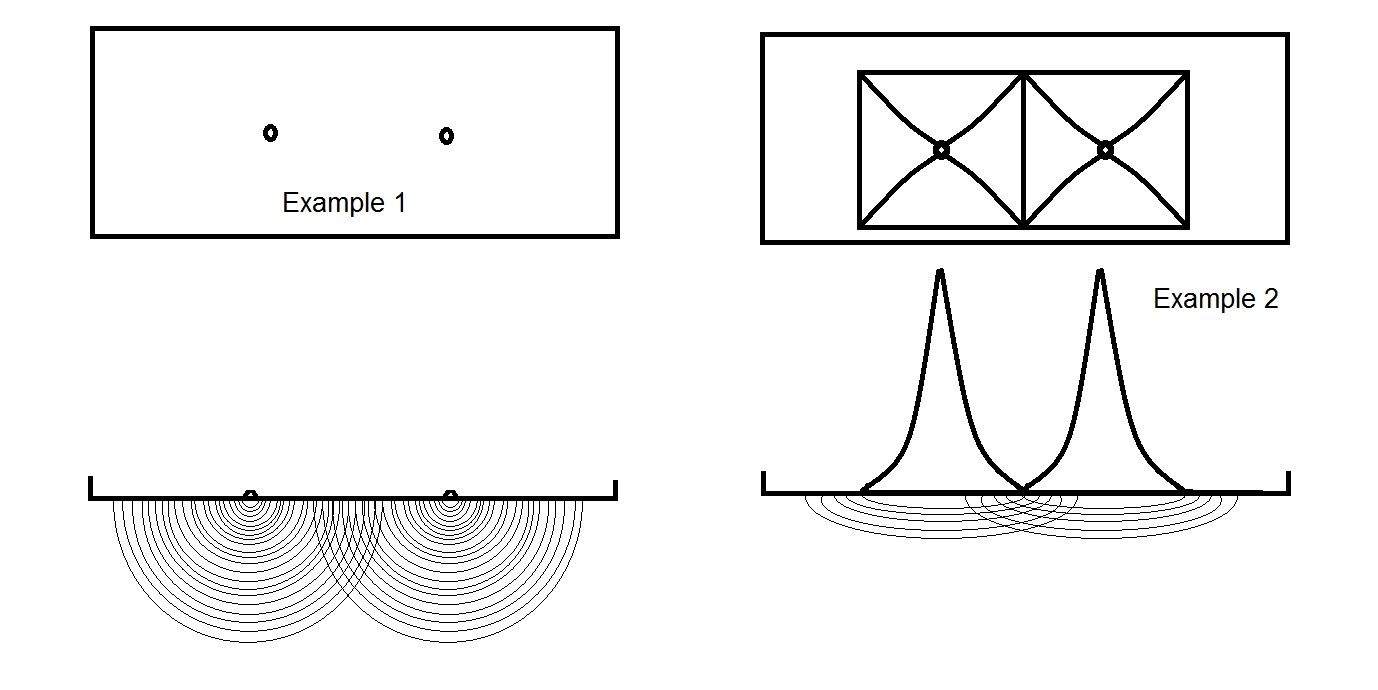
The shape of the wave exiting the horn is frequency dependent. Low frequencies spread out, and high frequencies beam - implying a very pronounced change in wave shape is occurring across the horn's frequency band. But that is not the point I'm trying to make. No one is arguing that horns do not beam at higher frequencies.
Assume for a moment that instead of bass horns, I install two 15' x 15' electrostatic speakers, side-by-side. How would you model that? Two point sources 15 feet apart? Or two large planar surfaces, joined directly side-by-side? I know it is not a truly equal comparison, but similarities exist nonetheless - which is that the mouth of a bass horn resembles a large radiating surface, and not necessarily a small point-source. What is happening way back in the throat, is happening way back in the throat. The mouth of the horn does not discriminate. The wave that exists the mouth is what propagates into free-space.
That's the point. Sustained standing waves, as in a room with room modes, are a problem. But the dynamic nature of music, stereo or not, is nothing like that out of doors.@Eric, I wonder whether the point (if there is one) might be whether standing waves are produced?
The crude water analogy is: I am floating in the water and 10 feet away, two kids are slightly correlated in kicking the water causing ripples heading my way. I might feel some ripples but nothing much. (There are a bunch ways this metaphor does not bear deeper parsing.)
There are coverage issues, but not wave interference issues to fuss over.
My impression is that the less educated and credentialed the poster, the longer they think their posts need to be (sad and untrue, of course).... and the more vicious and combative their stance. One jerk has been stalking me for years. Poor fellow.
B.
Last edited:
The shape of the wave exiting the horn is frequency dependent. Low frequencies spread out, and high frequencies beam - implying a very pronounced change in wave shape is occurring across the horn's frequency band. But that is not the point I'm trying to make. No one is arguing that horns do not beam at higher frequencies.
Assume for a moment that instead of bass horns, I install two 15' x 15' electrostatic speakers, side-by-side. How would you model that? Two point sources 15 feet apart? Or two large planar surfaces, joined directly side-by-side? I know it is not a truly equal comparison, but similarities exist nonetheless - which is that the mouth of a bass horn resembles a large radiating surface, and not necessarily a small point-source. What is happening way back in the throat, is happening way back in the throat. The mouth of the horn does not discriminate. The wave that exists the mouth is what propagates into free-space.
No, sound is round. The wavefront exiting the horn mouth is always roughly hemispherical. If you have links, evidence, proof that contradicts that post it. The mouth of a horn is a duct, a hole, not a radiating surface.
The crude water analogy is: I am floating in the water and 10 feet away, two kids are slightly correlated in kicking the water causing ripples heading my way. I might feel some ripples but nothing much. (There are a bunch ways this metaphor does not bear deeper parsing.)
A much better analogy for the two octave wide 20 db notch would be Godzilla doing a cannonball right beside you, you fall to the bottom in the huge hole made by the cannonball and you drown.
There are coverage issues, but not wave interference issues to fuss over.
These issues are one in the same. Any horn will cover the small designated listening area just fine, the only thing to worry about is the interference.
My impression is that the less educated and credentialed the poster, the longer they think their posts need to be (sad and untrue, of course).... and the more vicious and combative their stance. One jerk has been stalking me for years. Poor fellow.
B.
What do credentials have to do with anything? What are your credentials? You had an administrative job at an audio facility some 5 decades ago, so what? As weltersys is proving a long resume in the industry doesn't guarantee you know what you are talking about.
I've told you plenty of times, stop posting misinformation and I'll stop correcting you. The sheer amount of misinformation you post prompts a lot of corrections. That's not even close to stalking, get ahold of your ego, I don't follow you around, I just constantly stumble on your messes.
Here's a source, it took 2 seconds to find. https://www.grc.com/acoustics/an-introduction-to-horn-theory.pdf
The wave front shape stuff is at the end of the first article. The wave front starts getting curved in the throat and continues to be curved through the horn and exits the mouth curved.
Don't forget to look at the pics.
The wave front shape stuff is at the end of the first article. The wave front starts getting curved in the throat and continues to be curved through the horn and exits the mouth curved.
CURVED WAVE-FRONTS
By logical reasoning, the assumption
that the wave-fronts in a
horn are plane cannot be true.
If it was so, the speed of sound
along the horn walls would need
to be greater than the speed of
sound along the axis. This cannot
be the case, and the result is
that the wave-front on the axis
must gain on that at the horn
walls, so the wave-fronts will define
convex surfaces.
Don't forget to look at the pics.
Last edited:
No, sound is round. The wavefront exiting the horn mouth is always roughly hemispherical. If you have links, evidence, proof that contradicts that post it. The mouth of a horn is a duct, a hole, not a radiating surface.
"WAVE-FRONTS IN HORNS
In 1928, Hall conducted a detailed investigation
of the sound field inside horns4,
20 showing how the wave-fronts curve
in an exponential and a conical horn.
The wave-fronts in a 120Hz exponential
horn at the cutoff frequency are shown
in Fig. 14, where you can see that the
wave-fronts are very nearly normal to
the walls"
Horn Theory: An Introduction, Part 1
By Bjørn Kolbrek
That same reference (figure 34) & Keele's paper "What's So Sacred About Exponential Horns?" shows a multicell with >20cm cells.
If each cell was modeled as a central point, the multicell would have terrible lobing >850Hz due to the 20cm spacing between points, and the horn would only have one octave of bandwidth. In reality, they are actually fine for several octaves.
This implies that you cannot simply model a pair (or array) of horns as a pair (or array) of point sources.
If each cell was modeled as a central point, the multicell would have terrible lobing >850Hz due to the 20cm spacing between points, and the horn would only have one octave of bandwidth. In reality, they are actually fine for several octaves.
This implies that you cannot simply model a pair (or array) of horns as a pair (or array) of point sources.
Look at the pics (specifically pic 14 that's mentioned in that quote), the wavefronts are definitely curved. They are not anywhere near plane except way back in the throat where they start to curve based on path length difference between the horn wall and the horn centerline. Just look at the pics.
That same reference (figure 34) & Keele's paper "What's So Sacred About Exponential Horns?" shows a multicell with >20cm cells.
If each cell was modeled as a central point, the multicell would have terrible lobing >850Hz due to the 20cm spacing between points, and the horn would only have one octave of bandwidth. In reality, they are actually fine for several octaves.
This implies that you cannot simply model a pair (or array) of horns as a pair (or array) of point sources.
A multicell horn is not the same as side by side massive subwoofers. In the multicell horn it operates as a single horn at low frequencies. At high frequencies it beams very narrowly out of each cell and the cells are splayed out and pointing at different points in a hemisphere. The beaming and the hemispherical splaying both combine to keep the interference between cells at a minimum.
But even that isn't enough to eliminate overlap and interference. The "fingering" pattern in figure 34 is a direct result of destructive interference.
If you simulated this properly (including each of the cells pointing in different directions) you would get pretty close to the actual response, even the beaming could be simulated somewhat as the individual sources are so small.
No, sound is round. The wavefront exiting the horn mouth is always roughly hemispherical. If you have links, evidence, proof that contradicts that post it. The mouth of a horn is a duct, a hole, not a radiating surface.
Here’s actual soundwaves propagating from a horn.

And here’s how they made the waves visible:
Sound Engineering Academy: Neon Lamp Traces Sound Waves
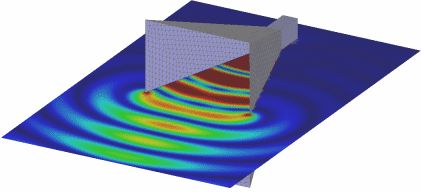
Horns are not point-sources. . ..

Here's point sources, showing destructive vs constructive interference:
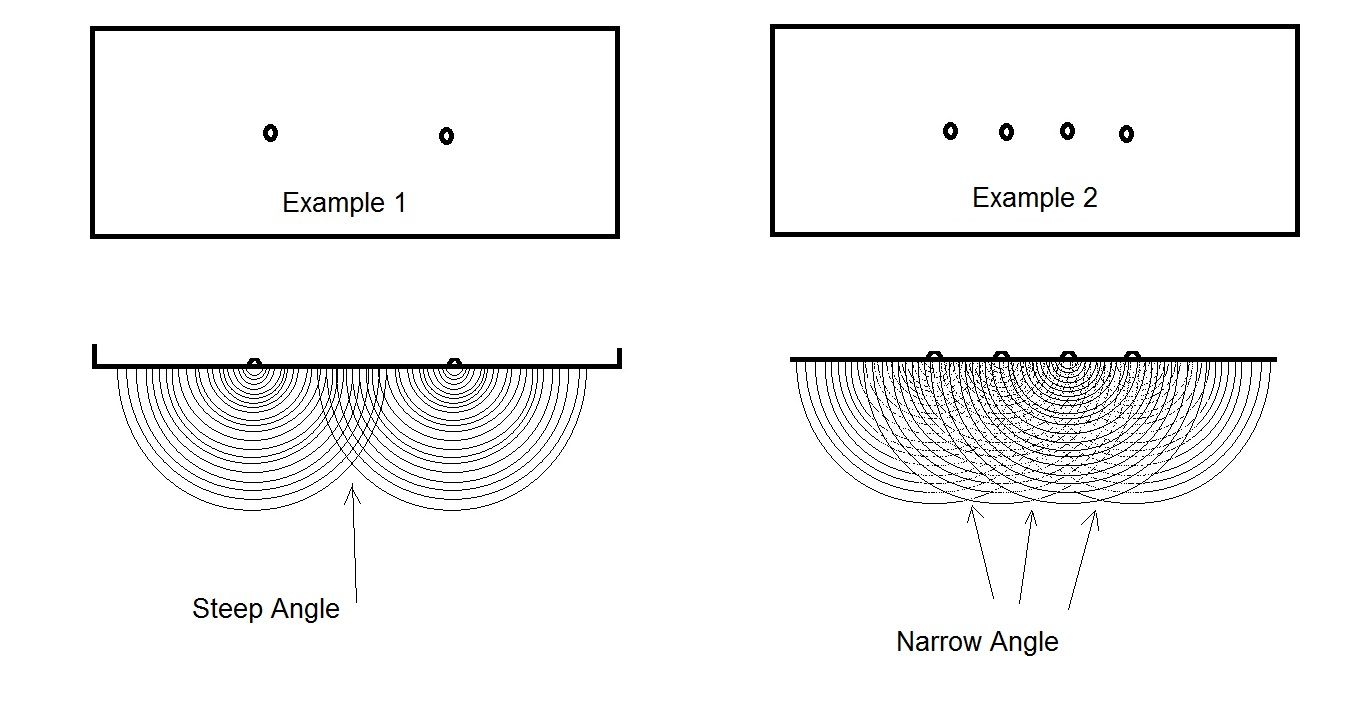
Last edited:
Assume for a moment that instead of bass horns, I install two 15' x 15' electrostatic speakers, side-by-side. How would you model that? Two point sources 15 feet apart? Or two large planar surfaces, joined directly side-by-side? I know it is not a truly equal comparison, but similarities exist nonetheless - which is that the mouth of a bass horn resembles a large radiating surface, and not necessarily a small point-source. What is happening way back in the throat, is happening way back in the throat. The mouth of the horn does not discriminate. The wave that exists the mouth is what propagates into free-space.
Attachment 1 shows the wavefronts propagated by two side-by-side planar surfaces radiating in-phase.
Attachment 2 shows the 'flattened spherical cap' wavefront at the mouth of an exponential horn.
Attachment 3 shows beaming at higher frequencies.
Attachments
There was a point in there somewhere forgive me if I forget it, this thread moves fast. Thanks for your anecdote 😀One of the prime reasons I'm building my system outside, is to free myself of room nodes.
Misleading
1) In the first figure presented, the feed-horn is to the left of an acoustic lens that is modifying the wave front not shown propagating from the horn.
2) All of the simulations that follow do not show wave diffraction and back-wave propagation taking place at the horn mouth(s).
3) Point sources in horn/driver output imaging occur behind, at, or in front of the driver depending on the relationship between wavelength and unit dimensions. To combine multiple sources, ideally point source distances should approach infinity.
4) HF radiation pattern narrowing is highly dependent on the rate of curvature declination in the horn throat. One figure is insufficient to address the issue.
Regards,
WHG
Here’s actual soundwaves propagating from a horn.

And here’s how they made the waves visible:
Sound Engineering Academy: Neon Lamp Traces Sound Waves

Horns are not point-sources. . ..
Here's point sources, showing destructive vs constructive interference:

1) In the first figure presented, the feed-horn is to the left of an acoustic lens that is modifying the wave front not shown propagating from the horn.
2) All of the simulations that follow do not show wave diffraction and back-wave propagation taking place at the horn mouth(s).
3) Point sources in horn/driver output imaging occur behind, at, or in front of the driver depending on the relationship between wavelength and unit dimensions. To combine multiple sources, ideally point source distances should approach infinity.
4) HF radiation pattern narrowing is highly dependent on the rate of curvature declination in the horn throat. One figure is insufficient to address the issue.
Regards,
WHG
Last edited:
I think we can all agree that if Eric insists on listening to sustained sine waves, he should do so with headphones.
B.
B.
Here’s actual soundwaves propagating from a horn.
Even in that picture (which appears to be a tiny conical horn feeding a lens from a couple feet back) the wavefront is curved.
Horns are not point-sources. . ..
I would say they are but you don't have to agree. The horn mouth isn't a source of anything though, it's just a duct that the wavefront passes through. Horns certainly are not producing a planar wavefront. Even if they were producing a planar wavefront like a tube does, the wavefront would start to curve as soon as it left the tube and entered free space. See figure 8 and 9 in the Kolbrek paper.
Here's point sources, showing destructive vs constructive interference:
The angle of incidence and overlap of the "narrow angle" wavefronts mixing looks just like the example 2 horns wavefronts mixing with the slight difference that the horn wavefront is a bit flatter (but still curved).
I think we can all agree that if Eric insists on listening to sustained sine waves, he should do so with headphones.
B.
Not sure how this is even vaguely on topic but I would disagree. Sine waves would be a lot more fun on huge horns, but sine waves are a bit boring.
I think the point you are trying to make is that comb filtering won't matter unless you listen to pure sine waves. This is not true, the sub frequencies are mixed mono and there will be interference with dual sub horn and between the horns and mains. Those deep two octave wide notches will produce entire octaves with missing notes in regular music too, not just sine waves.
- Home
- Loudspeakers
- Subwoofers
- Concrete Bass Horn Design Question
